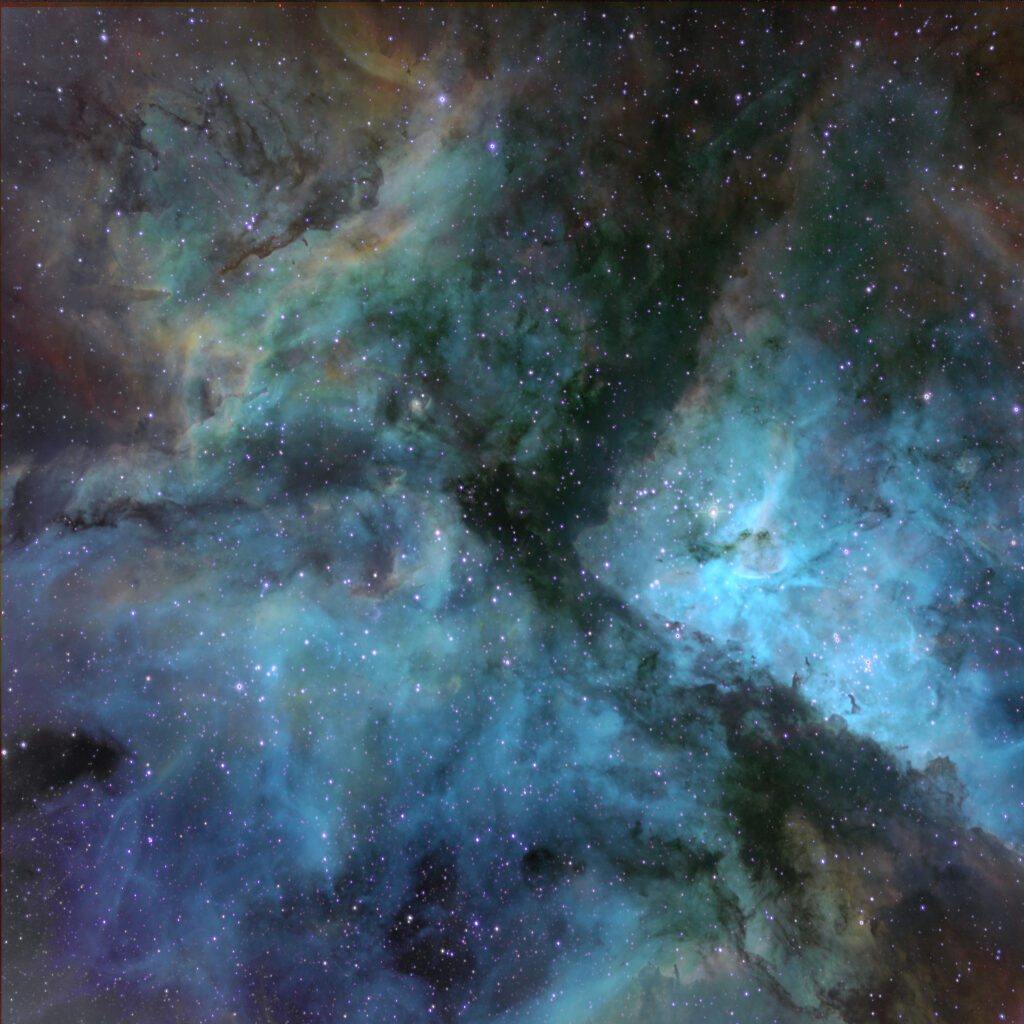Larger than the vast Orion Nebula, the Eta Carinae Nebula is less well known due to its location in the southern constellation Carina (the "keel"). A vast cloud of hydrogen gas spanning 300 light years, at a distance of 8,000 light years from Earth, the "Grand Nebula" is worthy of its name. It is a hotbed of stellar formation as regions of hydrogen coalesce to form a sphere that under sufficient pressure (from gravitational contraction) achieves the trigger temperature of 15 million degrees required to sustain nuclear fusion reactions. The energetic photons emitted by these young, hot stars illuminate the cloud of gas in visible light by a process similar to fluorescence.
I took this 2.5-hour image using the so-called “Hubble Palette” which was made famous by the Hubble Space Telescope's iconic image of the “Pillars of Creation.” NASA explains the “Hubble Palette” as follows: "The image depicts red light from hydrogen atoms as green, red light from sulfur ions (sulfur atoms with one electron removed) as red, and green light from doubly-ionized oxygen (oxygen atoms with two electrons missing) as blue. These color reassignments enhance the level of detail visible in the image, because otherwise the red light from hydrogen and that from sulfur would be hard to tell apart. In the final image, the blue-green haze indicates light from hydrogen and oxygen surrounding the dark areas. The image displays reddish highlights identifying light from sulfur."
Images taken with the Hubble Palette are false color, but provide clarity not possible with conventional red, green, and blue filters.
This was the first image I have taken using the Hubble Palette (Ha, SII, and OIII filters).
The "Grand Nebula" in Carina
Date Taken:March 14-16, 2014
Location Taken:Siding Spring Observatory NSW Australia
Conditions of Location: Equipment Used:Planewave 20" corrected Dall-Kirkham telescope, FLI PL09000 camera
Processing Used:9 x 10 minutes Ha, 8 x 3 minutes SII and OIII, for a total exposure of 2 hours and 12 minutes, processed in Maxim DL and Photoshop
Distance from Location: Constellation: Other Link:

Amazing image, very beautiful and nice colors. You are very good astrophotographer and i like natural look of your images. As amateur astrophotographer i know how much work you need for making one image.
I work with your son in Dalian, China, and he told me about your website. As I was looking at the details for this image, I noticed that the image was taken over the course of a couple days. This got me thinking about the nature of 3D photography. Basically two shots of the same “event” are taken from two different angles, and the results are combined either by crossing your eyes or by using a 3D display and some glasses. I was just wondering if you have every created any photos that might be viewed in this fashion? I have my doubts that 2 or 3 days would provide enough of a difference in viewing angle to provide any discernible depth. Do you think something like this would even be possible given the distances we’re talking about?
This picture was taken over two days because I took images using a hydrogen-alpha filter on one night, and then clouds prevented me from continuing. So, I came back a few nights later and took additional images using sulfur II and oxygen III filters. These three filters comprise the so-called “Hubble palette” that is frequently used by the Hubble Space Telescope. I am not familiar with stereoscopic 3D imaging of the heavens, but I will look into it. Sounds interesting!